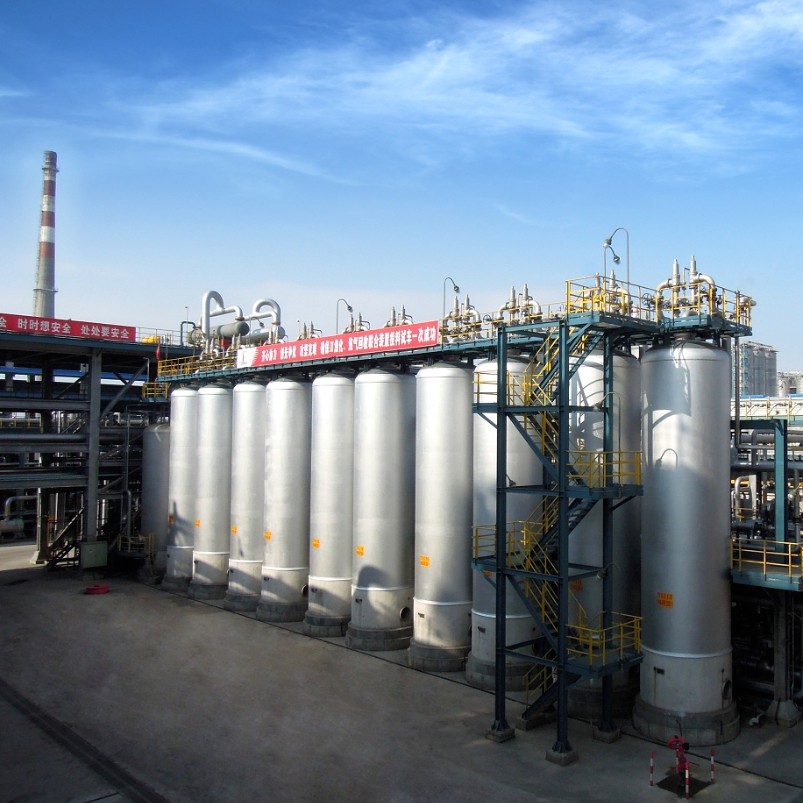Adsorbents are used for gas separation and purification. The properties of adsorbents are quite different, so how to choose right adsorbents?
Here are the things you have to know when you want to separate or purify gas mixtures:
1, The factors you must know when choosing adsorbents:
For the adsorption separation of gas mixtures, the equilibrium adsorption capacity of gas components and the separation coefficient between them are the two main indicators for evaluating and selecting adsorbents.
- the equilibrium adsorption capacity determines the amount of adsorbent used,
- the separation coefficient affects the separation effect between gases, which is finally reflected product gas purity and recovery rate.
The larger the separation coefficient α, the higher the product gas purity and recovery rate.
The separation performance of commonly used adsorbents for different gas mixtures is shown in Table 1-1 and Table 1-2.
Table 1-1 Equilibrium adsorption capacity of several gases on commonly used adsorbents (mL/g)
Gas | 5A molecular sieve | Activated carbon | Silica gel | Activated alumina |
H2 | 0.36 | 0.60 | 0.27 | 0.09 |
N2 | 8.64 | 4.49 | 1.20 | 0.33 |
CH4 | 12.94 | 14.01 | 2.77 | 0.76 |
CO | 23.29 | 6.34 | 1.91 | 0.50 |
CO2 | – | 31.67 | 23.18 | 19.08 |
C2H6 | 41.65 | 60.00 | 13.80 | 3.82 |
Note: adsorption temperature:25℃,adsorption pressure:100kPa
Table 1-2 Separation coefficient of mixed gases on commonly used adsorbents
5A molecular sieve | Activated carbon | Silica gel | Activated alumina | |
α(N2/H2) | 22.15 | 7.48 | 4.44 | 3.67 |
α(CO/H2) | 59.72 | 10.57 | 7.07 | 5.56 |
α(CH4/H2) | 33.18 | 23.35 | 10.26 | 8.44 |
α(CO/N2) | 2.70 | 1.41 | 1.59 | 1.52 |
α(CO/CH4) | 1.80 | 0.45 | 0.69 | 0.66 |
α(CH4/N2) | 1.50 | 3.12 | 2.31 | 2.30 |
α(CO2/N2) | – | 7.05 | 19.32 | 57.82 |
α(C2H6/CH4) | 3.22 | 4.28 | 4.98 | 5.03 |

2, Adsorbents for nitrogen and hydrogen separation
For mixture of nitrogen and hydrogen, the separation coefficient α(N2/H2)=7.48 on activated carbon is smaller than that of 22.15 on 5A molecular sieve (Table 1-2); and the equilibrium adsorption amount of nitrogen on 5A molecular sieve is 8.64 ml/g, which is much larger than that of 4.49 ml/g on activated carbon (Table 1-1), so 5A molecular sieve is usually chosen as the adsorbent for the separation of gas mixture of nitrogen and hydrogen.
3, Adsorbents for carbon monoxide and hydrogen separation.
For carbon monoxide-hydrogen mixture, although the α(CO/H2) of activated alumina and silica gel are 5.56 and 7.07 respectively, the adsorption capacity of carbon monoxide is too small, only 0.5ml/g and 1.91ml/g, which is not suitable for the separation of carbon monoxide-hydrogen mixture; while the α(CO/H2) of 5A molecular sieve and activated carbon adsorbent are more than 10, and the equilibrium adsorption capacity of carbon monoxide of molecular sieve is more than 3 times that of activated carbon, and it reaches 23ml/g, so the adsorbent of 5A molecular sieve is generally used for carbon monoxide-hydrogen gas mixture separation.
4, Adsorbents for methane and hydrogen separation.
For methane-hydrogen gas mixture, when selecting the adsorbent, considering that activated carbon has the largest equilibrium adsorption capacity and separation coefficient α(CH4/H2) for methane than 5A molecular sieve, silica gel and activated alumina, it is generally considered that activated carbon is more suitable for the separation of methane and hydrogen.
In conclusion, for gas mixture of nitrogen-hydrogen, carbon monoxide-hydrogen and methane-hydrogen, the separation coefficient is greater than 20 for 5A molecular sieve as well as activated carbon, indicating that the effective separation and purification of hydrogen can be achieved by using 5A molecular sieve or activated carbon.
5, Adsorbents for carbon monoxide and methane, carbon monoxide and nitrogen separation
For mixture of carbon monoxide-methane and carbon monoxide-nitrogen, the separation coefficients between the components are less than 3 for all four adsorbents in Table 1-2, indicating that these commonly used adsorbents are difficult to achieve the effective separation of these gas mixtures. For carbon monoxide-methane and carbon monoxide-nitrogen mixtures, it is generally necessary to use a Cu-loaded adsorbent, where Cu and CO can form complex bonds and effectively adsorb CO to improve the selectivity of CO adsorption.
6, Adsorbents for methane and nitrogen separation
For methane-nitrogen mixture, the α(CH4/N2) of 5A molecular sieve and activated carbon are 1.50 and 3.12 respectively, and the equilibrium adsorption capacities of methane are 12.94 ml/g and 14.01 ml/g, respectively, and the significant differences between them are mainly reflected in the separation coefficients. So activated carbon is more suitable for the separation of methane-nitrogen mixture; however, the activated carbon bulk density is smaller, and the volume of the adsorption tower will be larger.
